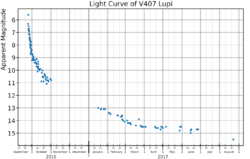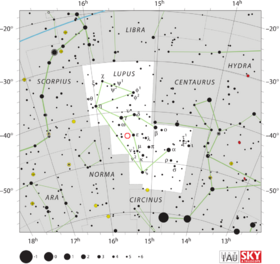Astronomy:V407 Lupi
| Observation data Equinox J2000.0]] (ICRS) | |
|---|---|
| Constellation | Lupus |
| Right ascension | 15h 29m 01.820s[1] |
| Declination | −44° 49′ 40.89″[1] |
| Apparent magnitude (V) | 5.6 – 14.8 [2] |
| Characteristics | |
| Variable type | Nova[3] |
| Other designations | |
| Database references | |
| SIMBAD | data |

V407 Lupi, also known as Nova Lupi 2016, was a bright nova in the constellation Lupus discovered by All Sky Automated Survey for SuperNovae (ASAS-SN) on 24.00 September 2016. At the time of its discovery, it had an apparent visual magnitude of 9.1. The ASAS-SN team reported that no object at the nova's location brighter than magnitude 17.5 was seen on images taken four days earlier.[5] Wildly incorrect coordinates (in error by many degrees) were published in the announcement telegram,[5] but corrected in a subsequent telegram.[1] It reached a peak brightness of magnitude 5.6, faintly visible to the naked eye, on 25 September 2016.[6] [7]
V407 Lupi declined from its peak brightness very quickly, fading by 2 magnitudes in less than three days. That is one of the most rapid declines in brightness ever seen in a nova. It is therefore classified as a "very fast" nova in the classification scheme of Cecilia Payne-Gaposchkin.[7][8]
All novae are binary stars, with a "donor" star orbiting a white dwarf. The two stars are so close to each other that matter is transferred from the donor to the white dwarf. Observations by the satellite TESS detected a variation in the light curve of V407 Lupi indicating an orbital period for the binary system of 3.513 days;[9] it was previously thought to be 3.573 hours,[10] but this has since been disproven.[9] A second periodicity in the light curve was also detected by the Chandra X-ray Observatory[7] and has a period of 591.27465 seconds (9.8545775 min), which appears to be the rotation period of the white dwarf.[9][11] The very rapid decline from peak brightness indicates that the mass of the white dwarf is ≥ 1.25 M☉, not far below the Chandrasekhar limit for white dwarf masses. The system is probably an intermediate polar nova.[7]
References
- ↑ 1.0 1.1 1.2 Stanek, K.Z.; Team, ASAS-SN (September 2016). "Erratum to ATel 9538: ASAS-SN Discovery of A Likely Galactic Nova ASASSN-16kt at V=9.1". The Astronomer's Telegram 9539: 1. Bibcode: 2016ATel.9539....1S. https://ui.adsabs.harvard.edu/abs/2016ATel.9539....1S. Retrieved 10 January 2021.
- ↑ "Download Data". AAVSO. https://www.aavso.org/data-download.
- ↑ Izzo, L.; Cano, Z.; de Ugarte Postigo, A.; Thoene, C.; Vanzi, L.; Zapata, A.; Espinoza, N.; Fernandez, D. et al. (October 2016). "Spectroscopic observations of Nova Lup 2016". The Astronomer's Telegram 9587: 1. Bibcode: 2016ATel.9587....1I. https://ui.adsabs.harvard.edu/abs/2016ATel.9587....1I. Retrieved 9 January 2021.
- ↑ "V4407 Lup". SIMBAD. Centre de données astronomiques de Strasbourg. http://simbad.u-strasbg.fr/simbad/sim-basic?Ident=V4407+Lup.
- ↑ 5.0 5.1 Stanek, K.Z.; Kochanek, C.S.; Brown, J.S.; Holoien, T.W.S.; Shields, J.; Shappee, B.J.; Prieto, J.L.; Bersier, D. et al. (September 2016). "ASAS-SN Discovery of A Likely Galactic Nova ASASSN-16kt at V=9.1". The Astronomer's Telegram 9538: 1. Bibcode: 2016ATel.9538....1S. https://ui.adsabs.harvard.edu/abs/2016ATel.9538....1S. Retrieved 11 January 2021.
- ↑ Watson, Christopher Watson, Christopher. "VSX : Detail for ASASSN-16kt". https://www.aavso.org/vsx/index.php?view=detail.top&oid=474105.
- ↑ 7.0 7.1 7.2 7.3 Aydi, E.; Orio, M.; Beardmore, A.P.; Ness, J.U.; Page, K.L.; Kuin, N.P.M.; Walter, F.M.; Buckley, D.A.H. et al. (October 2018). "Multiwavelength observations of V407 Lupi (ASASSN-16kt) - a very fast nova erupting in an intermediate polar". Monthly Notices of the Royal Astronomical Society 480 (1): 572–609. doi:10.1093/mnras/sty1759. Bibcode: 2018MNRAS.480..572A. https://ui.adsabs.harvard.edu/abs/2018MNRAS.480..572A. Retrieved 11 January 2021.
- ↑ Payne-Gaposchkin, Cecilia (1964). The galactic novae. New York: Dover. Bibcode: 1964gano.book.....P. https://ui.adsabs.harvard.edu/abs/1964gano.book.....P. Retrieved 11 January 2021.
- ↑ 9.0 9.1 9.2 Schaefer, Bradley E. (2021). "Discovery of 13 New Orbital Periods for Classical Novae". Research Notes of the AAS 5 (6): 150. doi:10.3847/2515-5172/ac0d5b. Bibcode: 2021RNAAS...5..150S.
- ↑ Beardmore, A.P.; Page, K.L.; Osborne, J.P.; Orio, M. (11 August 2021). "Swift observations of nova V407 Lup: detection of a UV period at 1.1 or 3.6 hours". The Astronomer's Telegram 10632. http://www.astronomerstelegram.org/?read=10632. Retrieved 11 January 2021.
- ↑ Beardmore, Andy; Dobrotka, Andrej; Ness, Jan-Uwe; Orio, Marina; Osborne, Julian; Page, Kim (September 2017). "Detection of a 9.4 min periodicity in the XMM-Newton and Chandra X-ray light curves of V407 Lup (Nova Lup 2016)". The Astronomer's Telegram 10749: 1. Bibcode: 2017ATel10749....1B. https://ui.adsabs.harvard.edu/abs/2017ATel10749....1B. Retrieved 11 January 2021.
 |


